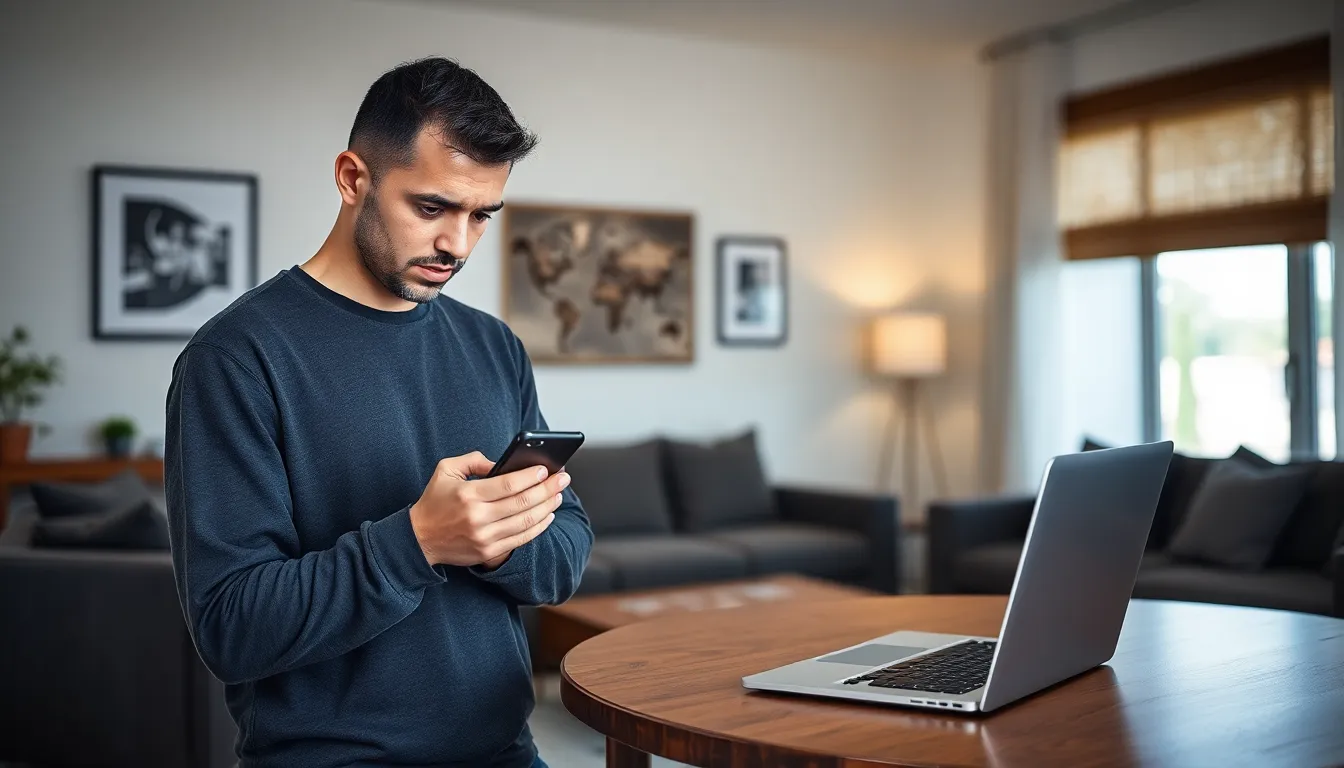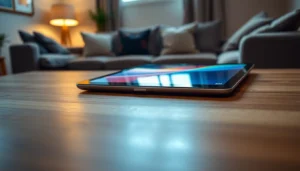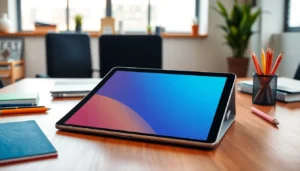Table of Contents
ToggleLosing an iPhone feels like losing a limb—suddenly, you’re cut off from your digital life. Panic sets in, and the questions flood your mind: How could this happen? What do I do now? But don’t worry; it’s not the end of the world. In fact, it’s a wake-up call to take control and act fast.
Immediate Steps to Take
When an iPhone gets stolen, immediate action is crucial. Quick thinking can help mitigate the risks associated with the loss.
Assess the Situation
First, check your surroundings. Look for any clues about where or how the device was taken. If you were in a crowded area, someone may have accidentally picked it up. Next, retrace your steps and visit nearby locations where you may have left it. Consider asking individuals who were in those locations if they noticed anything. Turning to Find My iPhone should be your next move. This features allows tracking your device’s location, making it easier to pinpoint its whereabouts or confirm the theft.
Report the Theft
Immediately report the stolen phone to local authorities. Provide them with your iPhone’s serial number, which can be found on the original packaging or your Apple ID account. Filing a report helps in recovering the device and serves as documentation. After reporting to the police, inform your carrier about the theft. Carriers often suspend service to prevent unauthorized use. They can also assist with locating the device through GPS tracking methods. Taking these steps ensures you’re doing everything possible to retrieve your stolen iPhone.
Use Find My iPhone

Find My iPhone offers essential tools for recovering a stolen device. Utilizing this feature helps manage the situation effectively.
Enable Lost Mode
Enabling Lost Mode secures the iPhone and displays a custom message on the screen. It allows the owner to set a phone number for contact. Accessing this option requires the iPhone to be listed in the Find My app. Activating this feature remotely locks the device and disables Apple Pay, protecting sensitive information. Additionally, familiarizing oneself with Lost Mode enhances the chances of recovery.
Track Your Device
Tracking the device becomes straightforward with the Find My iPhone app. Owners can view the device’s location on a map in real-time. If the iPhone is nearby, playing a sound helps locate it quickly. In cases where GPS tracking indicates the location, it’s crucial to proceed with caution. Avoid engaging directly with potential thieves. Instead, contacting local authorities proves safer and more effective. These functions significantly improve the likelihood of retrieving a stolen iPhone.
Notify Your Carrier
Reporting the theft to your carrier is crucial for preventing unauthorized use of your iPhone. They can assist in suspending service and protecting your account from potential charges.
Suspension of Service
Contact the carrier immediately to suspend your service. This disables the phone from making calls, sending texts, or using data. Carriers typically provide options for temporary service suspension, allowing you to maintain your number without incurring costs during the search for your device. Most providers require your account information and the device’s IMEI number, which can often be found on your original packaging or in your account settings. By taking this step, you minimize the chances of someone racking up charges on your account.
Device Protection Options
Explore options your carrier offers for device protection following a theft. Some carriers provide insurance plans, which may cover the cost of a replacement iPhone. Ask about the claims process to understand what documentation is needed and the timeline for reimbursement. In addition, inquire about any available remote locking features that your carrier may provide. Such features can help secure personal information, ensuring that sensitive data remains protected while you manage the aftermath of the theft. Leveraging these protections enhances your overall security posture after the loss of your device.
Change Your Passwords
Changing passwords immediately after losing an iPhone is essential for protecting personal information. Start with the Apple ID and iCloud accounts.
Apple ID and iCloud
Accessing the Apple ID settings on a different device or computer remains crucial. Change the password to ensure that no unauthorized user can access iCloud services. This step secures personal data stored in iCloud, such as contacts, photos, and documents. Additionally, enable two-factor authentication if it’s not already activated. Doing so provides an extra layer of security against unauthorized access.
Other Important Accounts
Next, address other critical accounts linked to the stolen device. Change passwords for email, banking, and social media accounts. Many services allow password recovery using the stolen device, making it necessary to act quickly. Consider using a password manager for generating and storing strong passwords. Regularly updating passwords enhances security, especially after a theft.
Consider Insurance or Replacement
Exploring insurance options after a stolen iPhone can simplify recovery and reduce financial burden. Several factors influence coverage, so understanding the specifics of your policy is essential.
Check Your Coverage
Reviewing your current insurance policy helps determine if it covers lost or stolen devices. Many homeowners or renters insurance policies include provisions for theft, while specific electronics plans may provide more targeted coverage. Verify the deductible, as it can impact the amount received upon a successful claim. Additionally, inquire about any exclusions that may apply and assess the process for reimbursement. Knowing the coverage limits allows for informed decisions about replacing the device.
Steps to File a Claim
Filing a claim involves several straightforward steps. Start by contacting your insurance provider to report the theft, providing them with details such as the iPhone’s make, model, and serial number. Gather necessary documentation, including the police report and any purchase receipts, to support the claim. Follow instructions for submitting the claim, which may include completing a claims form online or via phone. Once submitted, maintain contact with the insurer for updates. Tracking the claim status ensures timely compensation, helping to replace the stolen device efficiently.
Prevent Future Thefts
Taking proactive measures can significantly reduce the chances of future iPhone thefts. Implementing security features and using protective tools increases device safety.
Security Tips for Your iPhone
Enable passcodes on the device for immediate access protection. Regularly update to the latest iOS version, as updates often include security enhancements. Utilize Face ID or Touch ID to provide an extra layer of security. Avoid connecting to public Wi-Fi networks, which can make it easier for unauthorized users to access personal information. Installation of reputable security apps adds further protection by monitoring suspicious activity. Lastly, be cautious about sharing location services, as constant broadcasting of the device’s location presents potential risks.
Use of Tracking Apps
Tracking apps serve as essential tools for protecting devices. Activate Find My iPhone to secure the device and locate it in case of loss. Consider additional tracking apps that offer features like remote locking and data wiping to ensure personal information remains secure. Some applications notify the owner of the device’s location history, allowing for better tracking. Establish alerts for any unauthorized access attempts, which can prompt quick responses. Frequent checks on these apps ensure they’re functioning properly and ready to assist if an incident occurs.
Experiencing the theft of an iPhone can be overwhelming but taking swift action can significantly ease the situation. By utilizing the Find My iPhone feature and promptly notifying local authorities and your carrier, individuals can protect their personal information and potentially recover their device.
Changing passwords and enhancing security measures adds an extra layer of protection against unauthorized access. Exploring insurance options can also help mitigate financial loss.
Ultimately, staying vigilant and proactive can not only aid in the recovery process but also help prevent future incidents. Taking these steps empowers users to regain control and navigate the aftermath of a stolen iPhone with confidence.







